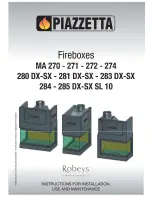
TROUBLESHOOTING
20
5.
TROUBLESHOOTING
This symbol means that a qualified professional should be called to perform the operation.
Problem
Probable causes
Solution
The fire does not light
properly
The fire does not stay
alight
Green or damp wood
Use hard woods, cut at least 2 years ago and stored in a
sheltered, ventilated place
The logs are too large
Use crumpled paper or firelighters and dry wood chips to light
the fire. Use split logs to keep the fire going
Poor-quality wood
Use hard woods which produce heat and embers (chestnut, ash,
maple, birch, elm, beech, etc.)
Insufficient primary air
Open the primary- and secondary-air intakes completely, or
even open the door slightly.
Open the outdoor-air inlet grille
Insufficient updraught
Check that the draught is not blocked. De-soot if necessary.
Check that the flue is in perfect condition (airtight, insulated,
dry, etc.)
The fire flames up too
much
Excessive primary air
Close the primary- and secondary-air intakes partially or totally
Excessive updraught
Install a draught damper
Smoke given off on
lighting
Poor-quality wood
Do not continually burn chips, carpentry scraps (plywood,
pallets, etc.)
Cold flue
Heat up the flue by burning a piece of paper in the firebox.
Smoke during burning
The room is at low
pressure
In rooms with Controlled Mechanical Ventilation, leave an
outdoor window ajar until the fire is fully alight.
Too little wood loaded
Load as recommended. Loads notably smaller than those
recommended lead to low smoke temperature and
downdraught.
Insufficient updraught
Check the condition of the flue and insulation.
Check that the piping is not blocked. Clean mechanically if
necessary
Wind enters the flue
Install an anti-downdraught system (Cowl) at the top of the
chimney
Does not warm up enough
The room is at low
pressure
In rooms with Controlled Mechanical Ventilation, there must be
an outdoor-air inlet
Poor-quality wood
Only use the recommended fuel
Water condenses (after
the appliance has been lit
more than 3 or 4 times)
Too little wood loaded
Load as recommended. Loads notably smaller than those
recommended lead to low smoke temperature and
condensation.
Green or damp wood
Use hard woods, cut at least 2 years ago and stored in a
sheltered, ventilated place.
Condition of the flue
Lengthen the flue (5-6 metres minimum). Insulate the flue
properly. Check the airtightness of the flue/appliance.
Summary of Contents for Tarbes
Page 1: ...Tarbes Instruction Book ...
Page 22: ...BASIC BREAKDOWNS 21 6 BASIC BREAKDOWNS ...
Page 23: ...BASIC BREAKDOWNS 22 6 ...
Page 24: ...DECLARATION OF PERFORMANCE 23 7 DECLARATION OF PERFORMANCE ...
Page 25: ...DECLARATION OF PERFORMANCE 24 7 ...
Page 26: ...CE MARK 25 8 CE MARK ...
Page 27: ......








































